Pitahaya Mexico Super Fruit Chef Alejandro 10 Experiences Tour Cozumel
Pitahaya, Mexico’s Tropical Super Fruit
Chef Alejandro Torres, 10 Experiences Tour Cozumel
The large variety of Mexican fruits is unique in the world. Given these are an important source of vitamins and minerals, they are an excellent option to eat daily in their beautiful natural form or making fresh drinks with them, delicious desserts such as pies, cakes, jams, smoothies, ice creams, sherbets and salads, only to name a few.
Short notes:
Pitahaya, or Pitzalli, is an exotic fruit. Its flower is white, fragrant, nocturnal and lives only one night. It is the largest of all cacti. Given its genus, hylocereus, it is different from the pitaya which belongs to the stenocereus.
Do you want to overcome and help your body against anemia and osteoporosis, then eat Pithaya frequently, with powerful antioxidant content, rich in minerals such as iron, calcium, phosphorus and vitamins B, C and E, has vegetable protein and soluble fiber.
Pitahaya is a fleshy fruit with a soft and sweet flavor, thick skin of red color, with scales and thorns. Its pulp sparks-off a grayish color, almost transparent showing many small black seeds. Its taste has a pleasant flavor no matter how it is prepared.
Even though it is a fruit native to the American Continent, it has been cultivated in several countries around the world such as Vietnam, Thailand, Malaysia and Israel. The main producers of pitahaya or dragon fruit in Mexico are Yucatan and Quintana Roo.
The name Pitahaya, of Antillean origin, means scaly fruit. This vine’s fruit sprouts three years after planting and can produce up to 90 fruits per harvest. Its active life is 15 years and is traditionally planted next to native and leafy trees.
Description:
THE PITAHAYA also known as dragon fruit. It is a cactus and as such barely needs water, thus is drought resistant. The plant is a succulent, rustic cactus, usually entangling in nearby trees feeding on the moisture of their bark and climbs up the branches up to eight or ten meters above the ground without penetrating the soil. The flower of the pitahaya is tubular, hermaphrodite and very beautiful, certainly ephemeral, meaning its life is short as it looks dazzling in the morning and when it feels the heat of the sun it swiftly dehydrates. It opens only once in the evening hours and its spirited scent attracts numerous insects. It is self-fertilizing but can also cross-pollinate. Bats are its best pollinators in the wild. Fruit formation from pollination to harvest lasts four to eight months depending on the temperature of the environment.
The ripe fruit is ovoid shaped, 10 cm long by 6 cm wide. Its weight varies between 200 and 400 gr. At its birth it usually shows a green color that turns yellow or deep red, depending on the variety. There are four in the market: red pitahaya with white flesh, red outside and inside, red with purple flesh, and yellow with white flesh. Its skin is scaly. This special feature gave rise to its name “pitahaya“, which means scaly fruit in Haitian. The rind has clusters of hard, sharp thorns that easily come off and must be carefully removed before harvesting the fruit to avoid pricking oneself.
The flesh of the dragon fruit is juicy, slightly gelatinous, and fibrous, full of small edible black seeds that give it a texture like a kiwi. It has a very fresh taste, with a bit of sharpness but pleasant to the palate. Thanks to the sweetness given by its natural sugar, these accentuate in accordance with the ripening process.
As it is usually sold without the sharp scales, just wash it lightly under the tap and cut it in half and reveal the pulp. Its edible flesh can be eaten directly with a spoon, using the rind as a bowl, or extracted with a spoon for serving.

It attracts for being so exotic and its refreshing taste is quite convincing, but without forgetting its healthy properties. It is very rich in fiber and water, with low caloric content that does not exceed 100 kcal per 100 gr. per edible portion. Therefore, is a source of carbohydrates, but with a very moderate energy intake.
In seasonal mixology, it is called Sonorita Shake Pitahaya Cocktail; lime juice, agave honey, bacanora (an agave-derived liquor from Sonora) and a touch of sparkling mineral water, you can prepare daiquiri, margarita and others that your imagination allows.
Pithaya, la súper fruta tropical mexicana
Chef Alejandro Torres, 10 Experiences Tour Cozumel
La gran variedad de frutas mexicanas es singular en el mundo; debido a su importante fuente de vitaminas y minerales son una excelente opción para consumirlas diario en su hermoso estado natural o bien en agua fresca, deliciosos postres como los ates, pasteles, mermeladas, licuados, helados, nieves y ensaladas por decir algunas.
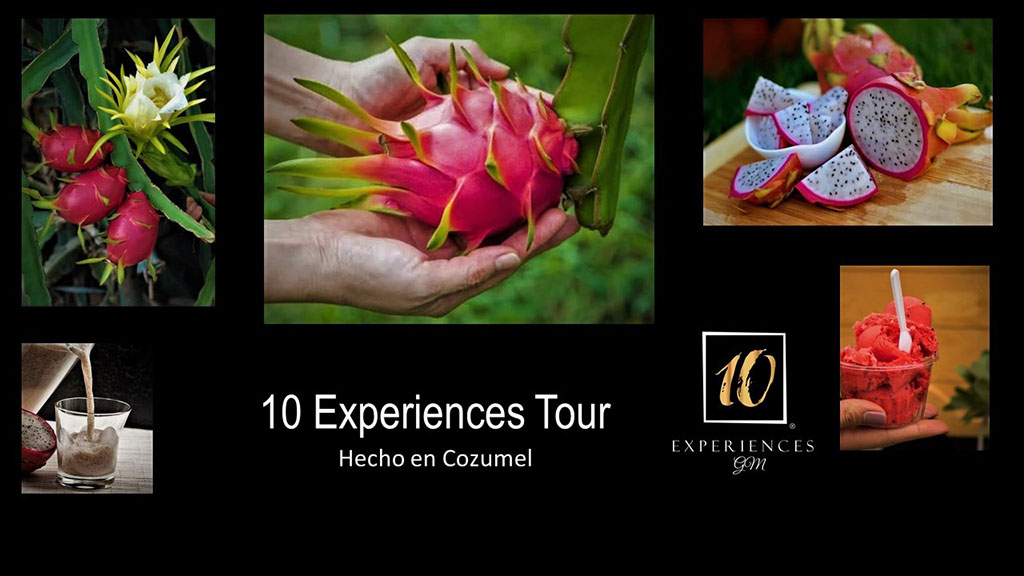
Breves:
La Pitahaya o Pitzallí, es un fruto exótico, la flor es blanca y fragante, nocturna y dura una sola noche, es la más grande de toda las cactáceas, por su género hylocereus es diferente a la pitaya que pertenece a los stenocereus.
Quieres combatir y ayudar a tu cuerpo ante la anemia y osteoporosis, consume frecuentemente la Pitahaya, poderoso contenido de antioxidante, rica en minerales como hierro, calcio, fosforo y vitaminas B, C y E, posee proteína vegetal y fibra soluble.
La pitahaya es un fruto carnoso de sabor suave y dulce, con piel gruesa de color rojo, con aletas y espinas, su pulpa interior detona color grisáceo, medio trasparente, dejando ver cualquier cantidad de pequeñas semillas negras, para el paladar, un sabor agradable de cualquier forma como se prepare.
Aunque es un fruto originario de América, se ha podido cultivar en varios países del mundo como Vietnam, Tailandia, Malasia e Israel, en México los principales productores de pitahaya o fruto del dragón son Yucatán y Quintana Roo.
El nombre Pitahaya de origen antillano significa fruta escamosa, La planta trepadora tiene su aguje a los tres años de sembrarla, puede generar hasta 90 frutos por cosecha, su vida activa es de 15 años, es tradición plantarlas junto a los árboles nativos y frondosos.
Descripción:
LA PITAHAYA conocida también como Fruta del Dragon, es una planta cactácea, y como tal de poca agua, resistente a las sequías. La planta es un cactus suculento, rústico, suele enredarse en los árboles próximos alimentándose de la humedad de su corteza y trepa por las ramas a ocho o diez metros del suelo sin penetrar en tierra. La flor de la pitahaya, que es tubular, hermafrodita y muy bella, ciertamente efímera es decir de vida muy corta, pues parece deslumbrante por la mañana y a medida que empieza a sentir el calor del sol se deshidrata súbitamente. Se abre una sola vez en las horas nocturnas y su brioso aroma atrae a numerosos insectos. Se autofecunda, pero también puede cruzarse, siendo los murciélagos los mejores polinizadores en su medio natural. La formación del fruto desde la polinización hasta la recolección dura de cuatro a ocho meses dependiendo de la temperatura del medio ambiente.
El fruto maduro tiene una forma ovoide de 10 cm de largo por 6 cm de ancho, su peso variable entre 200 y 400 gr. Suele presentar desde su nacimiento un color verde que se torna amarillo o rojo intenso, según la variedad, existen cuatro asentadas en el mercado; pitahaya roja de pulpa blanca, roja por fuera y por dentro, roja de pulpa púrpura, y amarilla de pulpa blanca. Presenta una piel escamosa de cuya especial característica surgió su nombre “pitahaya”, que en haitiano quiere decir fruta escamosa. Dicha corteza presenta grupos de espinas duras y agudas que se desprenden con facilidad, debiendo ser quitadas cuidadosamente antes de cosechar el fruto y evitar con ello su pinchazo.
La pulpa de la fruta del dragón es jugosa, ligeramente gelatinosa y fibrosa, llena de pequeñas semillas negras comestibles que aportan una textura similar al kiwi. Tiene un sabor muy fresco, con su punto ácido pero agradable al paladar, gracias al dulzor de sus azúcares naturales, estos se pronuncian en medida del proceso de maduración.
Para comerla, como ya se suele distribuir con las escamas afiladas recortadas, no hay más que lavarla ligeramente bajo el grifo y practicar un corte para partirla por la mitad y exponer la pulpa. Su carne comestible se puede consumir directamente con una cuchara, usando la corteza como cuenco o extraerla también con una cuchara para emplatar.
Atrae su atención por su exotismo y convence por su refrescante sabor, sin olvidar sus propiedades saludables. Es muy rica en fibra y agua, con bajo contenido calórico que no supera las 100 kcal por cada 100 gr. de porción comestible, siendo por tanto fuente de hidratos de carbono, pero con un aporte energético muy moderado.
Mixología de temporada, se llama Sonorita Shake Cóctel de Pitahaya; jugo de limón, miel de agave, bacanora y un toque de agua mineralizada, se pueden preparar daiquiri, margarita y otras hasta que la imaginación lo permita.
- Cozumel 4 You News April - April 18, 2024
- Cozumel Easter Vacation Semana Santa 2024 - April 18, 2024
- Cozumel Museum - April 18, 2024

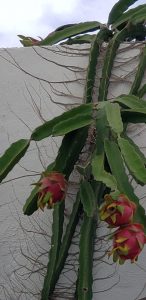
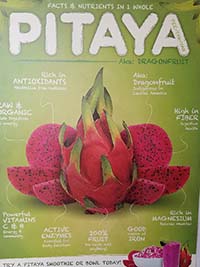
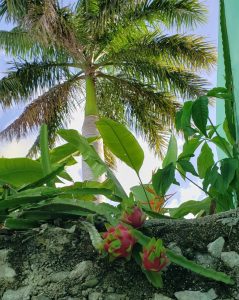
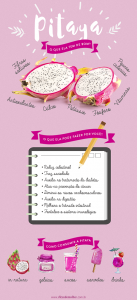






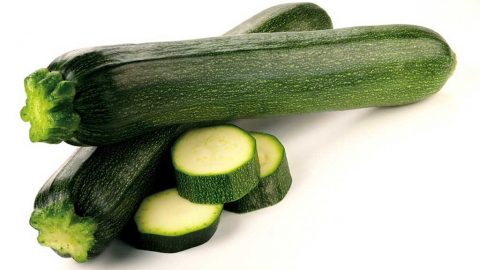











Wonderful! It is my favorite fruit! Thank you for the excellent material, Cozumel4you!